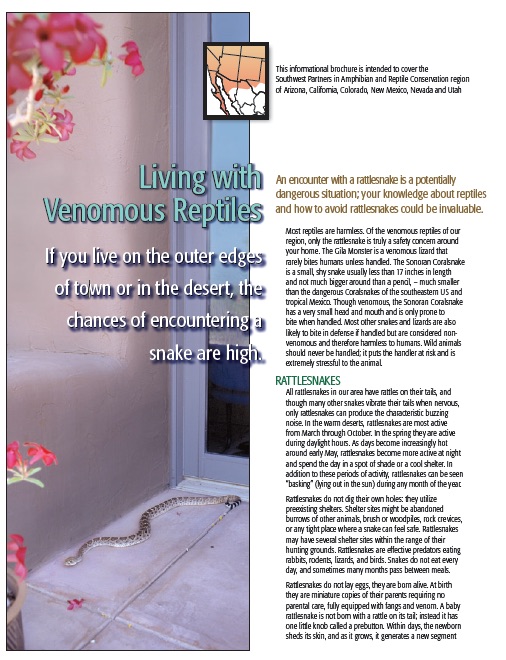Living With Venomous Reptiles – Click on cover to download pamphlet
In general, most reptiles are harmless. Of the venomous reptiles of our region, only the rattlesnake is truly a safety concern around your home. The Gila Monster is a venomous lizard that rarely bites humans unless handled. The Sonoran Coralsnake is a small, shy snake usually less than 17 inches in length and not much bigger around than a pencil — much smaller than the dangerous Coralsnakes of the southeastern US and tropical Mexico. Though venomous, the Sonoran Coralsnake has a very small head and mouth and is only prone to bite when handled. Most other snakes and lizards are also likely to bite in defense if handled but are considered nonvenomous and therefore harmless to humans. These wild animals should never be handled; it puts the handler at risk and is extremely stressful to the animal.
Get to the hospital as soon as possible if you do get bit by a rattlesnake. If your pet is attacked, seek immediate veterinary services. If you do not know for sure that the bite was from a rattlesnake, call the Arizona Poison and Drug Information Center’s 24-hour hotline: 1-800-222-1222.
Rattlesnakes
All rattlesnakes in our area have rattles on their tails, and though many other snakes vibrate their tails when nervous, only rattlesnakes can produce the characteristic buzzing noise. In the warm deserts, rattlesnakes are most active from March through October. In the spring they are active during daylight hours. As days become increasingly hot around early May, rattlesnakes become more active at night and spend the day in a spot of shade or a cool shelter. In addition to these periods of activity, rattlesnakes can be seen “basking” (lying out in the sun) during any month of the year.
Rattlesnakes Around Your Home
Watch your step! Rattlesnake colors and patterns allow them to blend with their surroundings. Always look where you place your feet and hands. A flashlight should be carried at night, especially on warm nights when rattlesnakes are very active. Around your home, keep walkways brightly lit and prune plants well away.
Rodent Control
Rattlesnakes are attracted to their vital resources, including food, water, and a safe place to live. Rodents should be eliminated from around your home. They are both destructive to your property and a primary source of food for rattlesnakes. Don’t feed birds in your yard! Bird feeders attract rodents just as effectively as birds. Snakes searching for a meal are often drawn to the scent of rodents and birds around feeders. There are effective products available for controlling rodents, such as snap traps and live traps. Sticky traps and poisons are also available, but they are often inhumane and might kill other animals and pets.
The Gila Monster
Because they are brightly colored, slow moving and rarely encountered, Gila Monsters can hardly be considered dangerous to humans. They are, however, capable of defending themselves with a surprisingly swift venomous bite.
The Gila Monster’s bite is a defensive measure. Few bites to humans have been reported, and nearly all are the result of individuals handling or harassing the animal. Note that because of their natural curiosity, small children and pets could put themselves at risk of being bitten by a Gila Monster. Be sure to keep both children and pet out of harm’s way if a Gila Monster is spotted!
The best advice: be cautious when you see one, especially in the spring when they emerge from their underground burrows. They should never be picked up or molested in any way; it puts one at risk — and disturbing them in any way is in violation of state wildlife regulations.
If you encounter a Gila Monster, stay out of its path. Give it room, and it will likely continue on its way. If you encounter one in the yard, move away, alert anyone in the vicinity, and restrain pets.
If a Gila Monster is left alone for a couple of hours, it will likely move on. If it does not leave after several hours or even after a day, you can contact your local Game and Fish Department office for advice. A commercial animal removal service should be called only as a last resort. They may relocate the animal too far from its home, jeopardizing the animal’s life.


